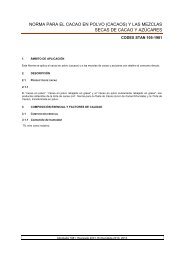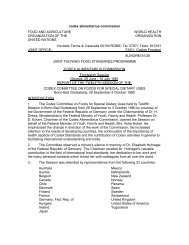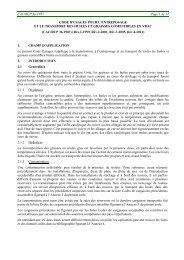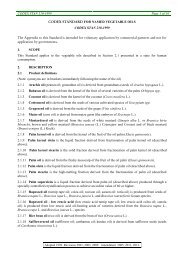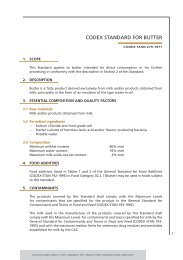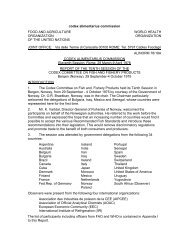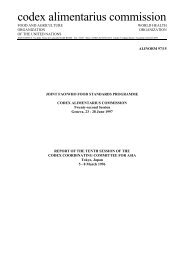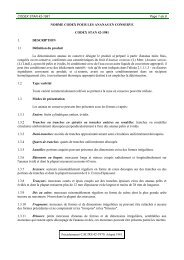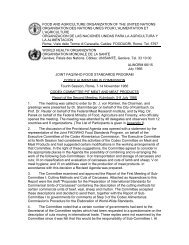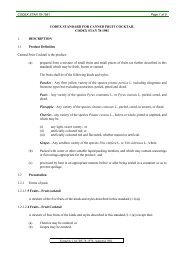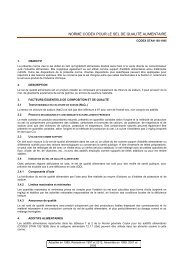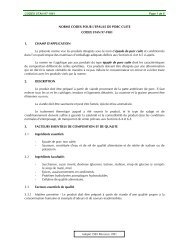REP13/FH JOINT FAO/WHO FOOD STANDARDS PROGRAMME ...
REP13/FH JOINT FAO/WHO FOOD STANDARDS PROGRAMME ...
REP13/FH JOINT FAO/WHO FOOD STANDARDS PROGRAMME ...
You also want an ePaper? Increase the reach of your titles
YUMPU automatically turns print PDFs into web optimized ePapers that Google loves.
<strong>REP13</strong>/<strong>FH</strong> Appendix IV 51<br />
2.3 Definitions<br />
Refer to definitions in the General Principles of Food Hygiene and the Code of Hygienic Practice for Fresh<br />
Fruits and Vegetables.<br />
SECTION 3 - PRIMARY PRODUCTION<br />
Berries are grown in production sites indoors (e.g. greenhouses) and outdoors, harvested, and may be field<br />
packed or transported to a packing establishment.<br />
3.1 Environmental hygiene<br />
3.1.1 Location of the production site<br />
Consideration of production site location should include an evaluation of the slope and the potential for runoff<br />
from nearby fields, flood risk as well as hydrological features of nearby sites in relation to the production<br />
fields. Growers should take measures to mitigate the risks associated with runoff and flooding, e.g. mapping<br />
the production field, terracing, construction of a shallow ditch to prevent runoff from entering the fields, etc.<br />
The effects of some environmental events, such as heavy rains, cannot be controlled. For example, heavy<br />
rains may increase the exposure of berries to pathogens if soil contaminated with pathogens splashes onto<br />
fruit surfaces. Where appropriate, growers should take into consideration natural uncontrolled events, such<br />
as heavy rains and evaluate postponing harvesting berries for direct consumption berries and/or to subject<br />
the berries to a treatment that will minimise the risk from pathogens. The risk of contamination is greatest<br />
when heavy rains cause flooding and flood waters come in direct contact with berries; berries that have been<br />
contacted with flood waters should not be used.<br />
Wet berries are very susceptible to spoilage and often resemble overripe berries leaking juice. Growers<br />
should allow a drying period, if possible, before harvesting berries to reduce the risk of contamination with<br />
foodborne pathogen.<br />
The proximity of high risk production sites, such as animal production facilities, hazardous waste sites and<br />
waste treatment facilities, should be evaluated for the potential to contaminate production fields or the water<br />
sources used with microbial or other environmental hazards via, for example, runoff, faecal material,<br />
aerosols or organic waste. When the risks are high these production sites should not be used for berry<br />
production unless adequate measures can be taken to mitigate the risks.<br />
3.1.2 Wild and domestic animals and human activity<br />
Many wild and domestic animal species and humans that may be present in the production environment are<br />
known to be potential carriers of foodborne pathogens. Domestic and wild animals and human activity can<br />
present a risk both from direct contamination of the crop and soil as well as from contamination of surface<br />
water sources and other inputs. The following should be considered:<br />
Domestic and wild animals should be excluded from the production area, to the extent possible, using<br />
appropriate biological, cultivation, physical and chemical pest control methods. Methods selected<br />
should comply with local, regional, and national environmental protection regulations.<br />
Berry production areas should be properly maintained to reduce the likelihood of vector attraction).<br />
Activities to consider include efforts to minimize standing water in fields, restrict access by animals to<br />
water sources (may be based on local ordinances for public irrigation systems), and keep production<br />
sites and handling areas free of waste and clutter.<br />
Berry production areas should be evaluated for evidence of the presence of wildlife or domestic animal<br />
activity (e.g. presence of animal faeces, bird nests, hairs/furs, large areas of animal tracks, burrowing,<br />
or decomposing remains). Where such evidence exists, growers should evaluate the risks and<br />
whether the affected parcel of the berry production site should not be harvested for direct<br />
consumption.<br />
3.2 Hygienic primary production of berries<br />
Berries are pulpy fruits with high moisture content and a soft skin, which makes them susceptible to physical<br />
damage that accelerates deterioration of berries by increasing water loss and provide conditions for<br />
contamination during production, harvest and transport. Physical damage to the berries may occur during<br />
harvesting from the use of sharp edged storage containers, improper field packing or through careless and<br />
poor handling. Rodents, insects and birds may also damage berries, leading to increased microbial spoilage<br />
and the potential transmission of foodborne pathogens. Growers should take measures to reduce the extent<br />
of damaged fruits during production.



